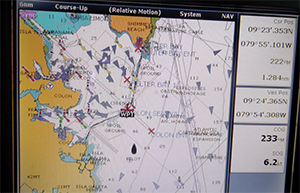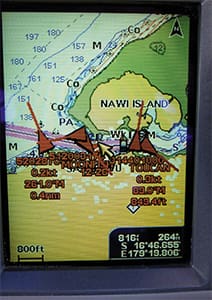To the editor: Aboard our Moody 422, Astarte, we love reading books about sailors of old. That’s when cruising by the sun, stars and moon were the norm. Finding your way through reefs was done with a lookout high in the rigging and sheer luck. Watch systems were strict and bells were rung to indicate the passing hours. We read with awe how these vessels made it to their designated port. Good seamanship was key to survival.
Now we have it pretty easy out here, relatively speaking. There are so many tools available to help with navigation, watches and repairs. GPS and chartplotters have made sextants, paper charts and dead reckoning just about obsolete on some boats. And, thanks to radar and AIS, some boaters now do watches while watching a movie in the comfort of the stateroom! Dependence on these tools is a big mistake, though. It is a dangerous habit to not do a real watch keeping a lookout for ships rather than enjoying a movie. It is not prudent seamanship.
As we left Opua, New Zealand, for our 1,170-nm passage to Fiji, we weren’t alone. The weather windows for passage from New Zealand to the islands of Tonga, Fiji, Vanuatu or New Caledonia were limited this season. So when a decent window opened up, everyone jumped on it and left “en masse.” We could see at least 10 boats as we left the Bay of Islands area. As night fell, the lights of our fellow cruisers were easy to see on the clear, dark night. As time passed, the boats spread out — faster ones moving ahead and us slowpokes in the back of the pack. We kept our eye on a boat behind us that was gaining on us and staying right on our track as if we had carved a trench. When they closed to less than two miles and didn’t veer off, we called them on the VHF radio. Their response was, “Where’s your AIS?”
We wanted to ask, “Where’s your person on watch?” Astarte has an automatic identification system (AIS) receiver but not a transponder. It’s on our wish list, but other “mission critical” items have eaten the budget. The AIS is a great tool. It gives you advance notice of big ships heading your way as well as the name of the vessel, plus its direction and speed. If you have an AIS transponder, you are also broadcasting that information to other vessels. But like the GPS, it can make you lazy. My husband Michael, a cameraman before becoming a full-time cruising captain, uses a great analogy to his past profession. He says that the best directors he worked with would always tell the camera operators to take their head out of the viewfinder. “Look around, see what’s going on.” By just keeping your eye on one small monitor, you don’t see the whole picture. The same is true for watches on passage. Don’t only look at the screen. Look around through 360 degrees. Often. That’s prudent seamanship.
 |
|
The authors’ Raymarine unit. They were amazed at how many AIS contacts showed up on their unit during their approach to Colon, Panama, and the canal entrance. |
|
Michael Hawkins |
The boat behind us never saw us until we called. If anything, they should have been extra alert knowing lots of boats left at the same time. But even then, they weren’t watching and the fact that every boat does NOT have an AIS transponder was shocking to them. Many boats, cruising yachts and local vessels, don’t have AIS — especially small local fishing boats. They sometimes don’t even have the proper lights. Recently in the news there was also a story of how some large fishing boats are turning off their AIS so they cannot be tracked when doing some illegal gathering. Add that to the fact that many vessels out here don’t have AIS; sometimes the equipment we are dependent on may not be working properly. We had a friend who thought his AIS was working when it wasn’t, and our AIS receiver has, on a few occasions, stopped receiving. In the saltwater environment, bouncing around on a boat taking big waves and big splashes and big crashes, electronic connections sometimes stop “connecting” properly. We may think they are all working and have a false sense of security. One thing you can count on to always work is a good set of eyes on watch.
Our voyage continued. Our watches continued — three hours on and three off. We saw very few other boats during this passage but we kept watching. About six days into the trip, we saw another boat right behind us. It was daylight and their sails were easy to see in the sunlight. They were about five miles behind and their AIS transponder was working though not holding a signal; it would come and go. They got closer and closer, again right behind us. It was a different boat than the previous encounter (that boat had long since passed us). As it approached to within less than two miles on a collision course with us, we called them. They responded: “Where’s your AIS?”
—Barbara Sobocinski and Michael Hawkins have been cruising full time since February 2009 aboard their Moody 422, Astarte. Currently they are enjoying the waters of Fiji.

